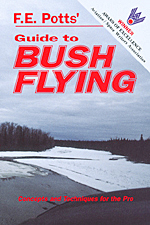"There is no doubt F. E. Potts' Guide to Bush Flying will become the standard text on the subject of bush flying"
A review by Doug Ritter and Scott Spangler
Flight Training Magazine
Bush flying is as demanding in its own way as flying in combat. The penalty for any lapse in skill or judgment can be equally final. These skills are hard won and jealously guarded, least other potential competitors learn the secrets.
While survival of the fittest may seem fitting to the circumstances of flying in the wilderness, it incurs a terrible waste of life. Fred Potts survived the process, noting, "My rabbit's foot got so overworked that I wore it out. Today there is hardly a hair left on it." After yet another close friend perished in a preventable flying accident, Potts decided he had to try to improve the odds.
F. E. Potts' Guide to Bush Flying -- Concepts and Techniques for the Pro is the welcome result. Potts' 22 years and 17,000 hours flying the bush in Alaska provide the experience from whence he speaks. However, it's his analytical approach, as well as his engaging writing, that raises this book above others that purport to prepare a pilot for this type of perilous flying.
Potts flys by the numbers, as well as by the seat of his pants. This approach inherently makes it easier for a pilot to learn. In a further departure from traditional books on the subject, he not only explains in detail how to do it, but also, most importantly, how to learn how to do it.
Non-pro pilots shouldn't be put off by the book's subtitle. This is a book that any pilot will enjoy and can learn from: seasoned pro, pro wanna-be, or student pilot. Moreover, the practical information Potts offers will be valuable to every pilot, even if the only bush flying being done is in the pilot's imagination. It will be the rare reader who finishes this book and doesn't have an urge to drop everything, buy a Super Cub and head North. Potts' love of flying and the Alaskan wilderness is evident on every page. The images he paints are enticing.
The best pilots are prepared for every eventuality, and this book will help make you a better pilot. Potts covers the basic and more arcane aspects of short and unimproved field operations with emphasis on developing the skills and judgment required to do it safely. Pilots interested in improving their short/soft field technique will find plenty here to help.
Many of the tips and techniques are especially appropriate to emergency landings; better by far than anything most pilots come across in their training. How to deal with non-standard approaches, curved landing spots and the like is covered in this book. All very good stuff to know when a perfectly level, straight, and adequate-length emergency landing spot isn't available and continuing the flight is no longer an option.
Potts also offers tried-and-true advice on engine care and management, including, as you might expect, excellent advice on cold weather operations. Flying on floats and skis is throughly covered, from selecting the equipment to the tricks of using and maintaining it. His discussions of weather are splendid, making this generally difficult and mysterious subject easier to understand. While the emphasis is on visual flight rules flight, his instrument flight rules flying tips contain practical, usable, advice.
Throughout the book's 267 pages, Potts emphasizes the importance of making sound, safe decisions and offers up his vivid, real-world experiences as examples. Potts makes it clear that nowhere is this more important than when flying down narrow, winding canyons into tiny, unimproved or rough strips. Any pilot considering bush flying as a career will gain a most insightful look at the hazards as well as the joys of flying in the bush.
The book's price, $34.95 in soft cover, might make some hesitate. The information in the book is well worth the expense.
There is no doubt that this will become the standard text on the subject of bush flying. But all pilots ought to have it on their bookshelves. Potts has written a fascinating and informative book that is a pleasure to read, lively and engrossing; it's hard to imagine a pilot who wouldn't enjoy it or benefit from it.
Doug Ritter is a well-known and versatile writer, editor, and survival expert. His web site at http://www.equipped.org/ is the foremost survival equipment resource on the net, and is a "must stop" for all pilots.
Scott Spangler is the Publisher and Editor of Flight Training Magazine.
Review Copyright © 1994 by Flight Training Magazine, all rights reserved. 201 Main Street, Parkville, MO 64152. Used by permission.
[Footnotes by F. E. Potts]
